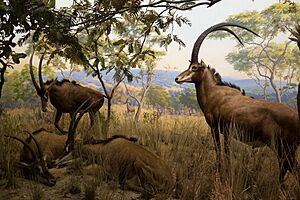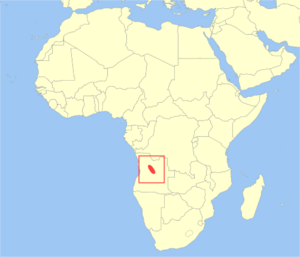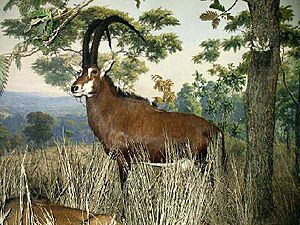Giant sable antelope facts for kids
Quick facts for kids Giant sable antelope |
|
|---|---|
 |
|
| Stuffed specimens at the American Natural History Museum, New York City | |
| Conservation status | |
| Scientific classification |
|
| Kingdom: | Animalia |
| Phylum: | Chordata |
| Class: | Mammalia |
| Order: | Artiodactyla |
| Family: | Bovidae |
| Subfamily: | Hippotraginae |
| Genus: | Hippotragus |
| Species: | |
| Subspecies: |
H. n. variani
|
| Trinomial name | |
| Hippotragus niger variani Thomas, 1916
|
|
 |
|
| Geographic range | |
The giant sable antelope (Hippotragus niger variani), also known as the royal sable antelope, is a very large and rare type of sable antelope. It lives only in a specific part of Angola, a country in Africa, between the Cuango and Luando Rivers. This means it is endemic to Angola.
For a long time, people weren't sure how many of these amazing animals were left. This was especially true after the Angolan Civil War. In 2004, a team led by Dr. Pedro Vaz Pinto used special cameras. They were able to take pictures of a herd in Cangandala National Park. This showed that some giant sable antelopes had survived.
The giant sable antelope is a very important symbol for Angola. People there respect it greatly. This might be one reason why these animals survived the long war. In African stories, antelopes often represent speed, beauty, and sharp senses.
Today, the giant sable antelope is listed as critically endangered. This means it is at a very high risk of disappearing forever. In 2021, there were only about 300 of them left. Around 100 of these live in Cangandala National Park.
Contents
What Does the Giant Sable Antelope Look Like?
Both male and female giant sable antelopes have horns. These horns can grow up to 1.5 meters (about 5 feet) long! Young males and females look quite similar. But when they turn three years old, the males start to change. They become much darker and grow impressive, curved horns.
Adult males weigh around 238 kilograms (525 pounds). They stand about 116 to 142 centimeters (46 to 56 inches) tall. Females are a bit lighter, weighing about 220 kilograms (485 pounds). They are also slightly shorter than the males.
The horns of males are very thick and curved. They can be 81 to 165 centimeters (32 to 65 inches) long. Female horns are shorter, usually 61 to 102 centimeters (24 to 40 inches) long. Adult males are black, while females and young ones are chestnut brown. However, in some southern areas, females can also be brownish-black.
Most sable antelopes have white "eyebrows" and white stripes on their faces. Their bellies and the patches on their rear are also white. Baby antelopes, under two months old, are usually light brown with faint markings. The longest giant sable antelope horns ever recorded were 65 inches long.
How Do Giant Sable Antelopes Behave?
Giant sable antelopes are usually shy animals. But they can also be very aggressive, especially the males. If a male is hurt, attacked, or approached too closely, it can be quite dangerous.
When males fight, they often kneel on their front legs. Then they wrestle using their horns. It's rare for these fights to cause serious injuries or deaths.
Young antelopes can be hunted by leopards and hyenas. Adult antelopes are mostly threatened by lions and crocodiles. If a giant sable antelope gets scared, it usually runs a short distance. Then it stops and looks back. But if it is chased, it can run very fast, up to 35 miles per hour (56 km/h), for a long time.
Where Do Giant Sable Antelopes Live?
Giant sable antelopes live in forests close to water. In these areas, leaves and tree sprouts are always fresh and plentiful. They are very picky eaters. They mostly eat tree leaves, which make up about 90% of their diet. They prefer leaves that are 40 to 140 millimeters (1.5 to 5.5 inches) from the ground.
Because they are critically endangered, these antelopes are protected in national parks. Hunting them is strictly forbidden.
Giant Sable Antelopes and Humans
The giant sable antelope is a proud national symbol of Angola. You can see its image on many things in the country. It appears on stamps, banknotes (money), and even Angolan passports.
The Angola national football team is lovingly called the Palancas Negras. This means "Black Antelopes" in Portuguese, honoring this special animal.



